http://www.technologyreview.com/
The Reliability of Tsunami Detection Buoys
The technology helped after Japan's earthquake,
but the buoy system is often unreliable.
Brittany Sauser 03/11/2011
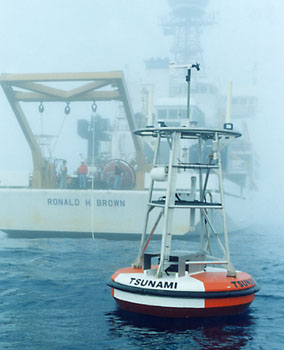
Credit: NOAA
The ocean-based tsunami detection system, known
as the deep-ocean assessment and reporting of tsunamis (DART),
which today sent
warnings to residents on the west coast of the United States and Hawaii
(as well as more than 50 other countries) is an unreliable system, according
to 2010
report. Of the 39 stations deployed in 2008 only an estimated 60% were
operational by
2009 (click here to see current active and inactive stations). The
report, issued by the National Research Council of the National Academy
of Sciences, concluded that the buoy stations, despite their technological
achievements, may not be a feasible long term solutions for providing improved
early warning and real-time reporting of tsunamis.
"The technology is good, but it's designed
for distance events like today," says Nathan
Wood, a research geographer at the U.S. Geological Survey and a member
of the committee that issued the report. The massive 8.9-magnitude earthquake
hit off the coast of Japan, giving residents of the United States enough
time to prepare or evacuate. Tsunamis are capable of hitting earthquake
stricken areas 15-20 minutes after the earthquake itself. But it takes
several minutes for researchers at tsunami warning centers to gather seismic
data, run models, and issue warnings. Having already lost about seven minutes,
for example, those close to the epicenter have little time to evacuate
or mobilize before the tsunami strikes, says Wood. Information from the
buoys is utilized, roughly, anywhere from 10-60 minutes after an earthquake
to confirm a tsunami event and determine the size of the waves. "There
is just not time for warnings when a local event occurs."
The DART
system was developed by the National Oceanic and Atmospheric Administration
in 2001. It consists of a bottom pressure recorder anchored to the seafloor
and a moored surface buoy. Data from the pressure recorder is transmitted
to the buoy via an acoustic link, and the buoy sends the data to a satellite
that communicates with a control station. Most of the buoys are located
in the Pacific Ocean where a tsunami landfall is thought to be more likely.
Other locations include the Atlantic Ocean and Carribean.
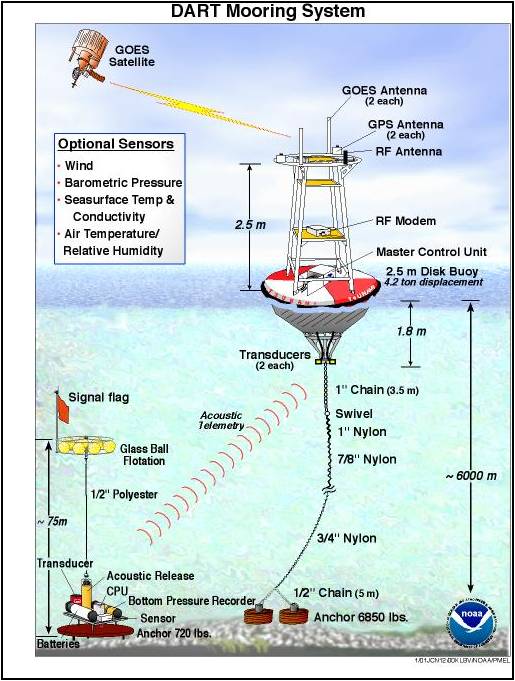
Credit: NOAA
Wood says the main problem with the buoy stations
is that they are hard and expensive to maintain, and because they are located
in a rather harsh environment, they have a fairly high failure rate. One
trip to fix a failed buoy could cost $25,000. Each station was designed
to be operational for at least four years, but after just one year, 2006,
nearly 20% of the buoys were inoperable. The NRS/NAS report stated that
at some points in time 30% or more of the buoys have been inoperable.
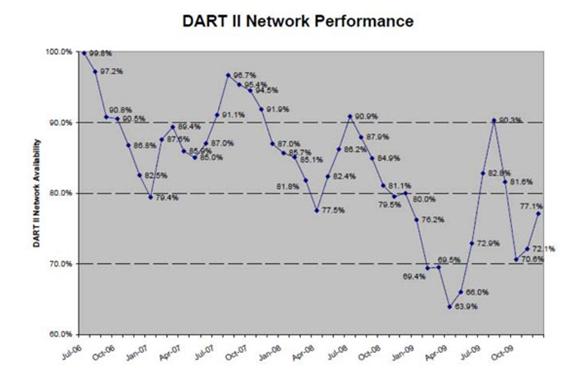
Credit: National Research Council
Another issue is that there is no "failure
analysis effort", says Wood. When the systems go offline it's difficult
to figure out why. And if one station becomes inoperable there is just
no coverage in that area.
The report recommends that NOAA conduct a
cost-benefit study and develop alternative methods. Wood says that while
the technology is valuable and can be effective, the financial constraints
of maintaining the stations might make them an unsustainable long term
solution.
What could make them better, he suggests,
is if the system could expand beyond just scientist getting information
via instant or text messages to people that need it to save lives or take
action. He adds that the buoy systems could be financially sustainable
if they were used for more than just tsunami warnings.
http://www.technologyreview.com/
How Japan's Earthquake and Tsunami Warning Systems Work
The world's only earthquake warning system
likely helped limit damage and loss of life.
Will Knight 03/11/2011
The earthquake that struck Japan early this
morning was the worst seen in that country for over 300 years (with a local
magnitude of 8.9). Hundreds have been killed and injured so far, but the
loss of life was likely limited by two vital early warning technologies:
a new earthquake alert system, and ocean-based tsunami warning system.
The earthquake warning system, which has never
been triggered before, automatically issued alerts via television and cell
phones shortly after the first, less harmful, shock wave was detected,
providing time for many people to prepare for the more powerful shock wave
that followed. It also caused many energy and industrial facilities, and
transportation services to shut down automatically. A string of detection
buoys in the Pacific Ocean detected the tsunami that resulted from the
earthquake, sending warnings of possible catastrophe to many different
nations. |
Here are some good resources that will help
you learn more about both warning systems.

Credit: Japan Meteorological Agency
The graphic above shows the stages involved
with triggered Japan's earthquake warning system. Further information can
be found at this
page of the Japan Meteorological Agency.
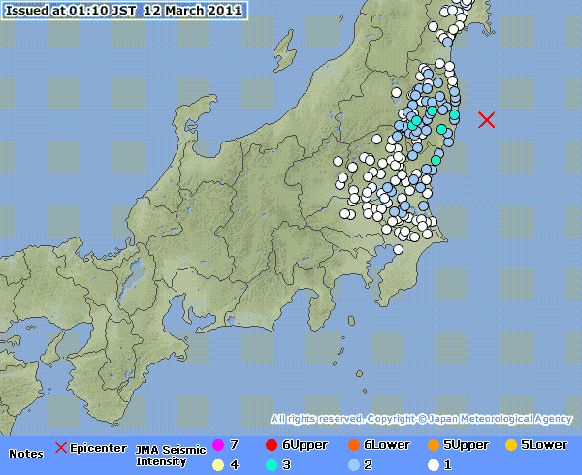
Credit: Japan Meteorological Agency.
This image shows the location of detected seismic
activity, and its severity (Japan uses a different scale for measuring
the intensity of earthquakes). Further information here.

Credit: NOAA
The graphic above shows how the Deep-ocean
Assessment and Reporting of Tsunami (DART) tsunami buoys work.
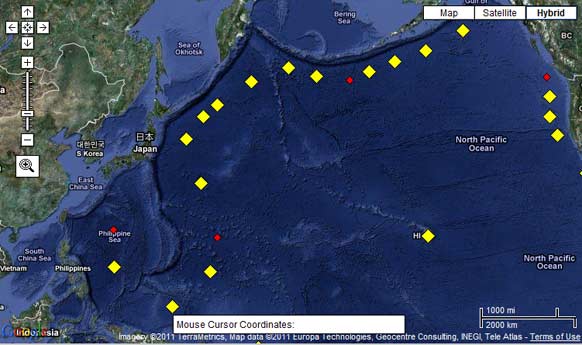
Credit: NOAA
The image above shows the location of tsunami
buoys across the Pacific, and which buoys have been triggered (the larger
yellow diamonds). Live information can be found in this
page at the National Oceanic and Atmospheric Administrations National
Data Buoy Center.
Updated 14:30 EST: NOAA has published a page
dedicated to the tsunami event.

Credit: NOAA.
The image above was generated using the method
of splitting tsunami (MOST) model. It uses data collected by tsunami
buoys to estimate the wave arrival time and the wave height of the tsunami.
http://www.technologyreview.com/
Earthquake Shakes Nuclear Power Plants in Japan
Power outages and fires have been reported
at multiple plants, and radiation leaks are possible.
Kevin Bullis 03/11/2011

A (pre-earthquake) aerial view of the Fukushima nuclear power plant.
Credit: Tokyo Electric Power Company.
The massive 8.9 magnitude earthquake in Japan
reportedly forced the automatic shutdown of 11 nuclear reactors at four
plants in the northeastern part of Japan near the earthquake's epicenter.
There have been no reports of radiation leaks, although Japanese news organizations
are reporting
that the radiation level within one of the plants is rising, and that radioactive
steam may
be released to reduce pressure buildup in the facility. [Update: Japan's
nuclear safety agency reportely says
the amount of radiation would not threaten human health.]
The earthquake cut off power to at least one
of the nuclear plants, the Fukushima plant, and backup generators failed
after an hour, forcing local governments to bring in mobile generators.
Even after an automatic shutdown, the reactors must be cooled—and without
power, cooling water cannot be circulated. [Update: A backup cooling system
that uses
batteries can temporarily delay overheating.]
There have been reports
that enough water remains in the reactors for cooling, and to prevent the
nuclear fuel from being exposed. The U.S. State Department has said that
the U.S. is bringing coolant to the plant, though Jasmina Vujic, a professor
of nuclear engineering at the University of California at Berkeley, says
it's not clear why that would be necessary, unless ordinary clean water—which
is all that's needed for coolant--is unavailable. [Update: reports that
the U.S. sent coolant may have been incorrect.]
A fire in one of the non-nuclear buildings
at another power plant has reportedly been extinguished.
Nuclear power plants in Japan are engineered
to withstand "extremely large earthquakes," and have survived major earthquakes
in recent years, Vujic says. She says they have "several layers of safety."
These include concrete walls comprising a total of nearly 20 feet of concrete
between the reactor and the outside, and five and a half inches of steel.

The reactors shut down automatically by inserting
control rods into the reactor; the rods absorb neutrons and immediately
stop the fission chain reactions inside the reactor.
Although no radiation leak has been confirmed,
nearly 3,000 people near the Fukushima plant have been evacuated as a precaution. |